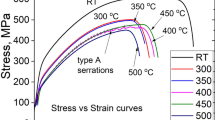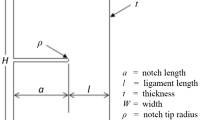Abstract
Single edge-notched bend (SENB) specimens containing shallow cracks (a/W < 0.2) are commonly employed for fracture testing of ferritic materials in the lower-transition region where extensive plasticity (but no significant ductile crack growth) precedes unstable fracture. Critical J-values J c ) for shallow crack specimens are significantly larger (factor of 2–3) than the J c )-values for corresponding deep crack specimens at identical temperatures. The increase of fracture toughness arises from the loss of constraint that occurs when the gross plastic zones of bending impinge on the otherwise autonomous crack-tip plastic zones. Consequently, SENB specimens with small and large a/W ratios loaded to the same J-value have markedly different crack-tip stresses under large-scale plasticity. Detailed, plane-strain finite-element analyses and a local stress-based criterion for cleavage fracture are combined to establish specimen size requirements (deformation limits) for testing in the transition region which assure a single parameter characterization of the crack-tip stress field. Moreover, these analyses provide a framework to correlate J c )-values with a/W ratio once the deformation limits are exceeded. The correlation procedure is shown to remove the geometry dependence of fracture toughness values for an A36 steel in the transition region across a/W ratios and to reduce the scatter of toughness values for nominally identical specimens.
Similar content being viewed by others
References
W.A. Sorem, R.H. Dodds, Jr and S.T. Rolfe, Structural Engineering and Engineering Materials, SL Report 89–1, The University of Kansas Center for Research, Inc. (1989).
G.Matsoukas, B.Cotterell and Y.W.Mai, Journal of the Mechanics and Physics of Solids 34 (1986) 499–510.
P.M. De Castro, J. Spurrier and P. Hancock, ASTM STP 677, American Society for Testing and Materials (1979) 486–497.
J.D.G.Sumpter, International Journal of Pressure Vessel and Piping 10 (1982) 169–180.
B.Cotterell, Q.F.Li, D.Z.Zhang and Y.W.Mai, Engineering Fracture Mechanics 21 (1985) 239–244.
Q.F.Li, Engineering Fracture Mechanics 22 (1985) 9–15.
Q.F.Li, L.Zhou and S.Li, Engineering Fracture Mechanics 23 (1986) 925–928.
D.Z.Zhang and H.Wang, Engineering Fracture Mechanics 26 (1987) 247–250.
J.D.G.Sumpter, Fatigue and Fracture of Engineering Materials and Structures 10 (1987) 479–493.
J.R.Rice, Journal of Applied Mechanics 35 (1968) 379–386.
J.R.Rice and M.A.Johnson, in Inelastic Behavior of Solids, M.F.Kanninenet al. (eds.), McGraw-Hill, New York (1970) 641–670.
R.O.Ritchie, J.F.Knott and J.R.Rice, Journal of the Mechanics and Physics of Solids 21 (1973) 395–410.
T.Lin, A.G.Evans and R.O.Ritchie, Journal of the Mechanics and Physics of Solids 34 (1986) 477–496.
J.W.Hutchinson, Journal of the Mechanics and Physics of Solids 16 (1968) 13–31.
J.R.Rice and G.F.Rosengren, Journal of the Mechanics and Physics of Solids 16 (1968) 1–12.
R.M. McMeeking and D.M. Parks, Elastic-Plastic Fracture, ASTM STP 668, American Society for Testing and Materials (1979) 175–194.
C.F.Shih and M.D.German, International Journal of Fracture 17 (1981) 27–43.
C.F.Shih, International Journal of Fracture 29 (1985) 73–84.
D.M. Parks and Y.Y. Yang, in Analytical, Numerical, and Experimental Aspects of Three Dimensional Fracture Processes, ASME/SES (1988) 19–32.
D.M. Parks, in Proceedings, EGF Conference on Elastic-Plastic Fracture, Freiburg (1989) to appear.
T.L. Anderson and S. Williams, ASTM STP 905, American Society for Testing and Materials (1986) 715–740.
T.L.Anderson and D.Stienstra, Journal of Testing and Evaluation 17 (1989) 46–53.
W.A. Sorem, R.H. Dodds, Jr and S.T. Rolfe, Nonlinear Fracture Mechanics: Volume II-Elastic-Plastic Fracture, ASTM STP 995, American Society for Testing and Materials (1989) 470–494.
C.F. Shih, Brown University Report, MRL E-147.
C.F.Shih, Journal of the Mechanics and Physics of Solids 29 (1981) 305–326.
J.R.Rice and D.M.Tracey, in Numerical and Computer Methods in Structural Mechanics, S.J.Fenveset al. (eds.), Academic Press, New York (1968) 585–623.
R.M.McMeeking, Journal of the Mechanics and Physics of Solids 25 (1977) 357–381.
T.L. Anderson and R.H. Dodds, Jr., submitted to Journal of Testing and Evaluation.
H.G.DeLorenzi and C.F.Shih, International Journal of Fracture 21 (1983) 195–220.
R.H., Dodds Jr., International Journal of Fracture 19 (1982) R75–R82.
J.Barlow, International Journal for Numerical Methods in Engineering 10 (1976) 243–251.
F.Z.Li, C.F.Shih and A.Needleman, Engineering Fracture Mechanics 21 (1985) 405–421.
C.F.Shih, B.Moran and T.Nakamura, International Journal of Fracture 30 (1986) 79–102.
PATRAN User's Manual, Release 2.3. PDA Engineering, Inc., Costa Mesa, California (1989).
R.H.Dodds and L.A.Lopez, International Journal for Engineering with Computers 13 (1985) 18–26.
J.R. Haigh and C.E. Richards, CEGB Report RD/L/M461 (1974).
R. Narasimhan and A.J. Rosakis, Report SM88–6, California Institute of Technology, Division of Engineering and Applied Science, Pasadena, California.
Author information
Authors and Affiliations
Rights and permissions
About this article
Cite this article
Dodds, R.H., Anderson, T.L. & Kirk, M.T. A framework to correlate a/W ratio effects on elastic-plastic fracture toughness (J c ). Int J Fract 48, 1–22 (1991). https://doi.org/10.1007/BF00012499
Received:
Accepted:
Issue Date:
DOI: https://doi.org/10.1007/BF00012499




